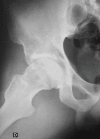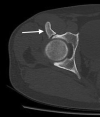Subspine Hip Impingement: Clinical and Radiographic Results of its Arthroscopic Treatment
- PMID: 33364650
- PMCID: PMC7748928
- DOI: 10.1055/s-0040-1713760
Subspine Hip Impingement: Clinical and Radiographic Results of its Arthroscopic Treatment
Abstract
Objective To evaluate the clinical and radiographic results as well as complications related to patients undergoing arthroscopic treatment of subspine hip impingement. Methods We retrospectively evaluated 25 patients (28 hips) who underwent arthroscopic treatment of subspine impingement between January 2012 and June 2018. The mean follow-up was 29.5 months, and the patients were evaluated clinically by using the Harris hip score modified by Byrd (MHHS), the non-arthritic hip score (NAHS), and in terms of internal rotation and hip flexion. In addition, the following items were evaluated by imaging exams: the center-edge (CE) acetabular angle, the Alpha angle, the presence of a sign of the posterior wall, the degree of arthrosis, the presence of heterotopic hip ossification, and the Hetsroni classification for subspine impingement. Results There was an average postoperative increase of 26.9 points for the MHHS, 25.4 for the NAHS ( p < 0.0001), 10.5° in internal rotation ( p < 0.0024), and 7.9° for hip flexion ( p < 0.0001). As for the radiographic evaluation, an average reduction of 3.3° in the CE angle and of 31.6° for the Alpha angle ( p < 0.0001). Eighteen cases (64.3%) were classified as grade 0 osteoarthritis of Tönnis, and 10 (35.7%) were classified as Tönnis grade 1. Two cases (7.1%) presented grade 1 ossification of Brooker. Most hips ( n = 15, 53.6%) were classified as type II of Hetsroni et al. Conclusion In the present study, patients undergoing arthroscopic treatment with subspine impingement showed improvement in clinical aspects and radiographic patterns measured postoperatively, with an average follow-up of 29.5 months.
Keywords: arthroscopy; femoroacetabular impingement; hip joint.
Sociedade Brasileira de Ortopedia e Traumatologia. This is an open access article published by Thieme under the terms of the Creative Commons Attribution-NonDerivative-NonCommercial License, permitting copying and reproduction so long as the original work is given appropriate credit. Contents may not be used for commercial purposes, or adapted, remixed, transformed or built upon. ( https://creativecommons.org/licenses/by-nc-nd/4.0/ ).
Conflict of interest statement
Conflito de Interesses Os autores declaram não haver conflito de interesses.
Figures










Similar articles
-
Extracapsular approach for arthroscopic treatment of femoroacetabular impingement: clinical and radiographic results and complications.Rev Bras Ortop. 2015 Jul 3;50(4):430-7. doi: 10.1016/j.rboe.2015.06.011. eCollection 2015 Jul-Aug. Rev Bras Ortop. 2015. PMID: 26401501 Free PMC article.
-
Arthroscopic Management of Subspinous Impingement in Borderline Hip Dysplasia and Outcomes Compared With a Matched Cohort With Nondysplastic Femoroacetabular Impingement.Am J Sports Med. 2020 Oct;48(12):2919-2926. doi: 10.1177/0363546520951202. Epub 2020 Sep 8. Am J Sports Med. 2020. PMID: 32898429
-
Anatomic footprint of the direct head of the rectus femoris origin: cadaveric study and clinical series of hips after arthroscopic anterior inferior iliac spine/subspine decompression.Arthroscopy. 2013 Dec;29(12):1932-40. doi: 10.1016/j.arthro.2013.08.023. Epub 2013 Oct 18. Arthroscopy. 2013. PMID: 24140143
-
Revisiting the Anteroinferior Iliac Spine: Is the Subspine Pathologic? A Clinical and Radiographic Evaluation.Clin Orthop Relat Res. 2018 Jul;476(7):1494-1502. doi: 10.1097/01.blo.0000533626.25502.e1. Clin Orthop Relat Res. 2018. PMID: 29794857 Free PMC article.
-
Arthroscopic Treatment of Acetabular Retroversion With Acetabuloplasty and Subspine Decompression: A Matched Comparison With Patients Undergoing Arthroscopic Treatment for Focal Pincer-Type Femoroacetabular Impingement.Orthop J Sports Med. 2018 Jul 11;6(7):2325967118783741. doi: 10.1177/2325967118783741. eCollection 2018 Jul. Orthop J Sports Med. 2018. PMID: 30046631 Free PMC article.
Cited by
-
Imaging Diagnosis, Prevalence, and Clinical Outcomes of Arthroscopic Surgery for Anterior Inferior Iliac Spine Impingement: A Systematic Review and Meta-analysis.Orthop J Sports Med. 2022 Nov 11;10(11):23259671221131341. doi: 10.1177/23259671221131341. eCollection 2022 Nov. Orthop J Sports Med. 2022. PMID: 36389619 Free PMC article. Review.
-
The case of 'A Rhino Horn': case report and proposal for modification to the Hetsroni and Kelly classification.J Hip Preserv Surg. 2021 Jun 23;8(Suppl 1):i51-i59. doi: 10.1093/jhps/hnab020. eCollection 2021 Jun. J Hip Preserv Surg. 2021. PMID: 34178372 Free PMC article.
-
Finite Element Analysis of Femoral-Acetabular Impingement (FAI) Based on Three-Dimensional Reconstruction.J Healthc Eng. 2022 Feb 27;2022:2937056. doi: 10.1155/2022/2937056. eCollection 2022. J Healthc Eng. 2022. Retraction in: J Healthc Eng. 2023 Oct 11;2023:9836713. doi: 10.1155/2023/9836713. PMID: 35265295 Free PMC article. Retracted.
-
What the papers say.J Hip Preserv Surg. 2021 Aug 8;7(4):789-791. doi: 10.1093/jhps/hnab053. eCollection 2020 Dec. J Hip Preserv Surg. 2021. PMID: 34377523 Free PMC article. No abstract available.
-
Heterotopic Ossification After Arthroscopic Procedures: A Scoping Review of the Literature.Orthop J Sports Med. 2022 Jan 18;10(1):23259671211060040. doi: 10.1177/23259671211060040. eCollection 2022 Jan. Orthop J Sports Med. 2022. PMID: 35071654 Free PMC article.
References
-
- Ganz R, Gill T J, Gautier E, Ganz K, Krügel N, Berlemann U. Surgical dislocation of the adult hip a technique with full access to the femoral head and acetabulum without the risk of avascular necrosis. J Bone Joint Surg Br. 2001;83(08):1119–1124. - PubMed
-
- Ito K, Minka M A, II, Leunig M, Werlen S, Ganz R. Femoroacetabular impingement and the cam-effect. A MRI-based quantitative anatomical study of the femoral head-neck offset. J Bone Joint Surg Br. 2001;83(02):171–176. - PubMed
-
- Wagner S, Hofstetter W, Chiquet M. Early osteoarthritic changes of human femoral head cartilage subsequent to femoro-acetabular impingement. Osteoarthritis Cartilage. 2003;11(07):508–518. - PubMed
-
- Espinosa N, Beck M, Rothenfluh D A, Ganz R, Leunig M.Treatment of femoro-acetabular impingement: preliminary results of labral refixation. Surgical technique J Bone Joint Surg Am 200789(Suppl 2 Pt.1):36–53. - PubMed
-
- Ali A M, Teh J, Whitwell D, Ostlere S. Ischiofemoral impingement: a retrospective analysis of cases in a specialist orthopaedic centre over a four-year period. Hip Int. 2013;23(03):263–268. - PubMed
LinkOut - more resources
Full Text Sources
Research Materials

